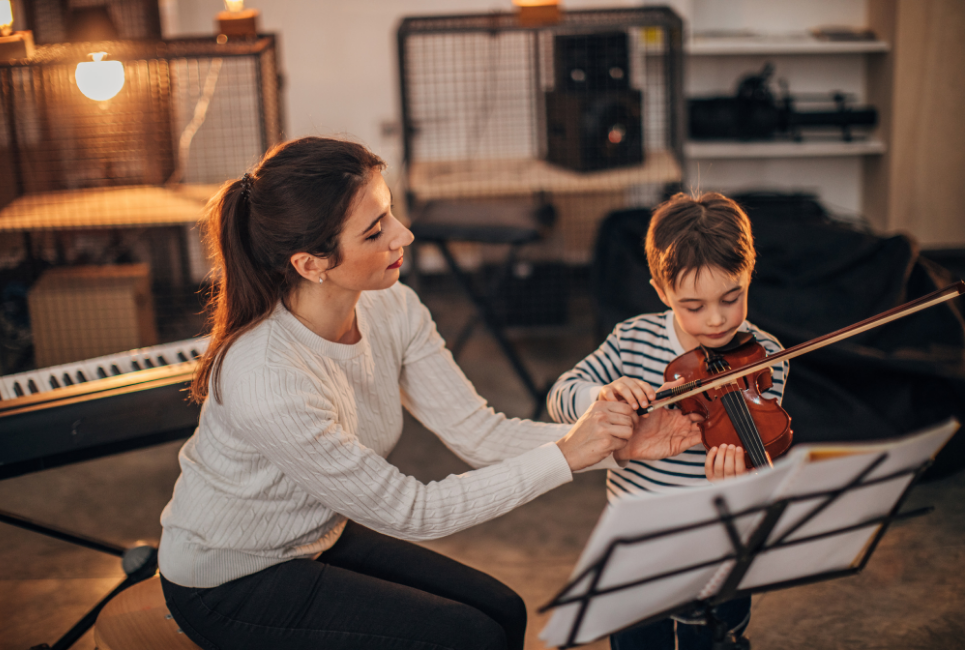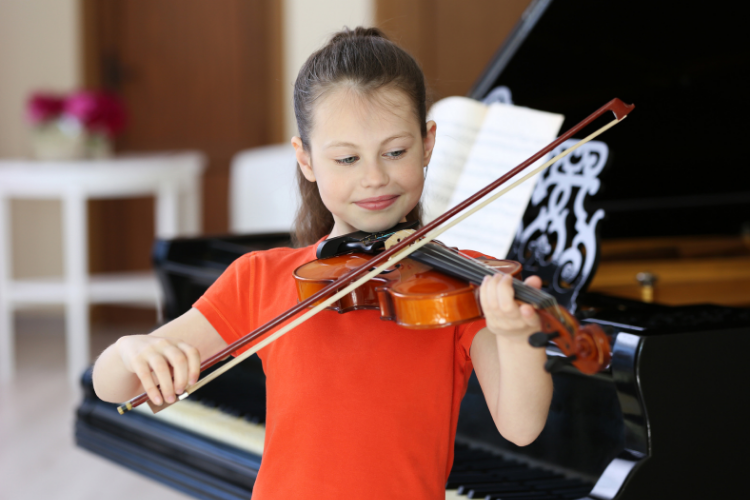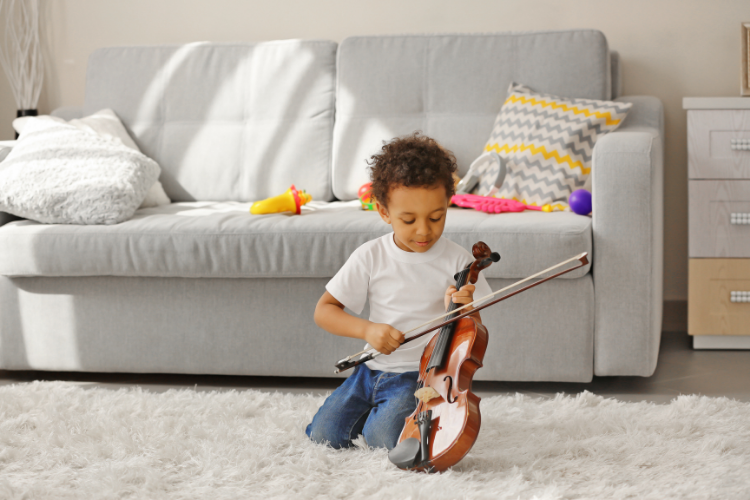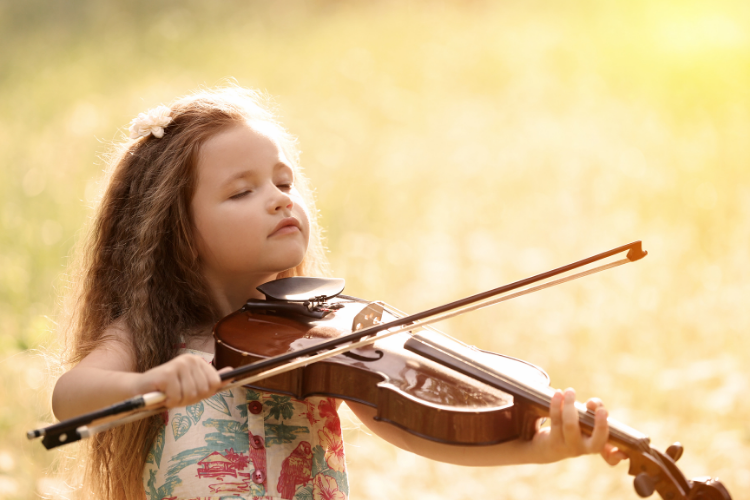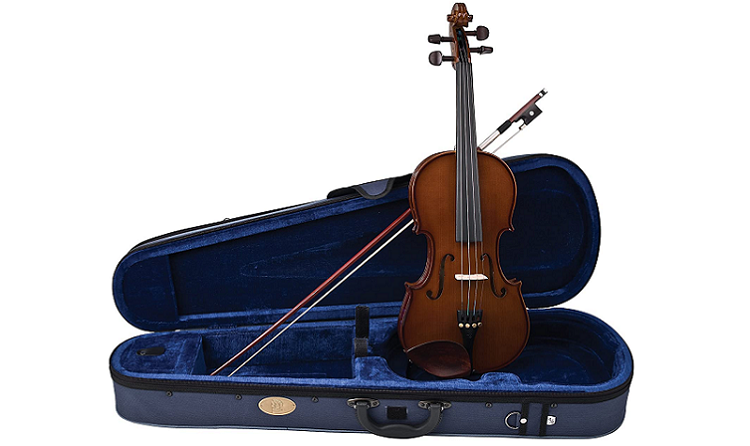- How to Find the Best 5 String Violins - April 21, 2022
- How to Hold a Violin Bow - April 21, 2022
- How to Hold a Cello Bow - April 17, 2022
Summary: Knowing how to find the best 1/16 violin means appreciating that this size is intended for small children and comes in the form of a toy. Toy violins of this size are a great way to introduce your children to music and musical instruments.
Suppose you have a small member of your family who is just now beginning to show an interest in music, or perhaps your entire family consists of musicians, and now the youngest member of your family wants to participate in the tradition. In that case, you need to know how to find the best 1/16 violin.
What is a 1/16 Violin?
The 1/16 size violin is one of the most miniature violins on the market. It is sometimes referred to as a toy violin. The 1/16 violin comes with a variety of designs and features which can facilitate the most critical lessons in a solid musical foundation.
That said, a 1/16 violin is referred to as a toy violin for a good reason; it is a violin-type toy. However, it serves the same purpose as other educational toys in that a small member of your family can still develop an interest in music, Still pretend to play the violin, and still utilize the correct arm and hand positions so that when they matriculate to a slightly larger size, they already know the basics of how the instrument works.
A 1/16 violin is typically a toy shaped like a violin and has buttons and design elements that look like strings but are not actual strings. Children also have bows that accompany this size which replicate the look and feel of a violin bow but without the horsehair design.
Who Should Use a 1/16 Violin?
A 1/16 violin is meant for small children between 2 and 3. That said, violins are sized based on the length of the instrument and the length of the musician’s corresponding arm span.
So, you could very well have a three-year-old with a longer arm span than an average three-year-old who needs to transition up to the next size violin, a mini violin or a 1/8 sized.
The table below gives you a good idea of what sizes are best for which ages and arm lengths:
| 1/8 | Children 5 years old
Arm span between 17.1 inches and 17.5 inches |
| 1/10 | Children 4 years old
Arm span between 15 ⅜ inches and 17 inches |
| 1/16 | Children 2-3 years old
Arm span between 14 inches and 15 ⅜ inches |
Who Should Avoid a 1/16 Violin?
I once taught a Japanese three-year-old with a university music professor as a mother and a mathematician as a father. From the beginning, I was humbled at this child’s ability to match pitch, read music, and already play the piano.
The parents wanted their child to start playing the violin because the other children in their family played the violin. The child I taught was three years old but was far too advanced for a fake toy.
This child had the discipline, maturity, and, most importantly, the arm span to accommodate a 1/10 size. They got a little bigger within a few months, and I moved them up to a 1/8 size violin.
If your child shows particular musical abilities well beyond their age or they are significantly larger than average children their age, you might consider investing in a different sized instrument.
However, if you have a small child in your home who just wants an educational toy with which they can learn the basics of playing the violin and have a good time, a 1/16 sized toy violin is the perfect companion.
Why Should Children Play the Best 1/16 Violin?
You might wonder why children should even bother playing the best 1/16 violin when it is nothing more than a toy. I had the same thought when I first learned about toy violins. I couldn’t imagine that playing a toy instrument would be of any use or benefit. That was, of course, before I had children of my own.
Now I’m older, wiser, and well-read on the subject of early exposure to music in young children. 1/16 size violins are an excellent way to get children engaged in music at a very early age.
It is also an effective bonding tool if you already have siblings who play instruments because the older sibling can practice their instrument while the younger sibling picks up their toy violin and pretends to practice alongside them.
I can tell you from personal experience that watching your seven-year-old groan in frustration as they try to practice their scales, all the while having a three-year-old sibling underfoot with a sparkly, light-up toy violin, is worth every penny.
But more than just annoying their siblings, children should play the best 1/16 violin because it helps them figure out how to hold the instrument.
It gives them the opportunity to get comfortable moving the bow back and forth along the fake strings so that when they invariably transition to legitimate lessons and a legitimate set of strings, they will already know the movements.
For beginners, body position and techniques are two of the most critical aspects of playing the violin. Where the violin sits, where the shoulder rests sits, how the head is held while the violin is played, and where the chin rest goes are all critical lessons no matter when someone starts playing the violin.
If you can introduce these lessons to your child before they pick up a legitimate instrument, you will save them months of struggle when they first take a music class or private lessons.
Playing an instrument of any kind can be intimidating. When I started playing an instrument, I didn’t get private lessons. I got a general music class in school. And this meant that I had to learn everything from start to finish in front of all of my peers.
And there were only a few other kids in my class who played the same instrument I did so everyone could tell when I messed up. Children who can understand the basics of playing an instrument gain self-confidence to overcome this initial intimidation.
Learning to play with the best 1/16 violin helps children connect fun and excitement with music and instruments, which will ease their nerves down the line as they continue with any form of music.
What Features Matter in the Best 1/16 Violin
When evaluating different 1/16 size violins, it’s up to you as the parent or teacher to decide which model will most improve creativity and motor skills. For example:
- If you have a two-year-old who just had their birthday, is very small, and is not prepared to handle a real musical instrument, they can still focus on their motor skills and have fun with a brightly colored toy that comes with a lot of engaging sounds and colors. In these cases, a 1/16 violin with different buttons they can press to create a violin sound might be a thrill.
- If you have a three-year-old who is about to turn 4, it might be time to find a 1/16 violin that encourages their musical abilities with the same general shape and size of a violin so that they can learn how to hold the instrument and how to move the bow. With more advanced toy models like this, there are not only engaging sounds, but there are features where, as the child moves the bow across the strings, the toy strings are pressed by the bow pressure and generate sounds. This recreates the same effect as running an actual bow across actual strings.
- Some models have buttons up and down the neck of the violin, which gets pressed when the child runs the toy bow across that section of the instrument. Pressing those buttons engages music. Children can enjoy dozens of sounds with flashing lights and a variety of bright colors, perfect for children on the younger end of this spectrum.
- Other models have different levels of activity and engagement with built-in songs. So, a child using these 1/16 size violins can hit a button on the violin and get introduced to classical music by Mozart, Paganini, and Bach. There are also plenty of violins that allow children to record and playback their creations.
- I would recommend looking for a 1/16 size toy violin with volume control settings. If you can find a model with different settings, you can control just how loud playtime is.
What to Avoid with a 1/16 Violin
Be advised that small parts can be problematic to younger children. Avoid having any choking hazards in your home or your music classes by getting a 1/16 violin appropriate for the age you have in your home or the age you are teaching in music school.
One of my best friends owns a kindermusik company where she teaches music to very small children. In fact, some of her classes are designed to introduce music to children while they are still in the womb.
Her classes for slightly older children, like toddlers, utilize toy violins and other toy instruments to teach children the basics of music. Still, children under the age of two are not allowed to use these toy violins because of the liability.
Consider that liability when making decisions for your own home or your studio as well. Make sure that you have the right size for the age and the arm length of the child.
1/16th Violin Recommendations
1/16th violins may be tiny, but they are not cheap. This is why most rent, so their little musicians can conveniently move up to a bigger size when needed. Still, if you really want to buy a little violin for your tiny tot, I’ve rounded up some of the best ones.
Top Pick: Cremona SV-75
The Cremona SV-75 is an excellent tiny violin that will look great as a sentimental decoration. This violin is their cheapest offering from well-known orchestral string dealers and comes with all of the basics to get you started. It’s made from quality spruce and maple tonewoods. This violin will get the best tone a tiny violin can manage, which really is mostly squeaks. The pets are hardwood, and I imagine, and so is the fingerboard, but I’ll be honest, it won’t matter. Your little one isn’t going to spend enough time with this violin for it to matter. It comes well set up and ready to play with four fine tuners, a case, and a bow. It’s a tiny violin that will pass your teacher’s inspection.
Pros
- Inexpensive for a tiny violin
- Made with quality construction
- Comes set up and ready to play
- Comes with Prelude strings great for students
Cons
- Very basic accessories
- Hardwood fittings
Higher Quality Pick: Tower Strings Entertainer
Suppose you really want to start your little musician off with the right violin. In that case, the Tower Strings Entertainer from Fiddlerhsop is one of my favorite starter violins. Fiddlershop uses the highest quality tonewoods and fittings, so you know your student will start with one of the best instruments around. Made from aged spruce and maple tonewoods, along with 100% ebony fittings and a carbon composite tailpiece with four built-in fine tuners. This violin comes strung with D’Addario Prelude strings and a full outfit with a case, brazilwood bow, rosin, practice mute, and digital tuner. This will be a great pick if you have multiple small musicians as it holds up for years of use.
Pros
- Aged solid carved tonewoods at an inexpensive price
- Given the stamp of approval from professional musicians
- Comes with everything you need to play
- Fully set up, just tune and go
Cons
- Expensive for a violin that will only be used a year or two
Another High-Quality Pick: Bunnel Premier
The Bunnel Premier is another higher-priced and higher quality pick from the retailers at Kennedy Violins. The Bunnel Premier is one of the few 1/16th violins that Kennedy offers. Its made from high-quality spruce and ample with a hand-rubbed finish and ebony fittings. My favorite part about this pick is that the violin is hand set up in their west coast based workshop to give your violin the best sound right out of the case. With everything you need to get started, including a case, rosin, Prelude strings, shoulder rest, and an intro to violin book, you will be able to play your first open strings within a few hours. This violin will also please many teachers.
Pros
- Fully hand setup and ready to play to MENC standards
- Comes with everything you will need to get started
- Quality tonewoods and fittings with a Wittner style tailpiece
- Really pretty finish that will look great as a sentimental wall piece once your child moves on
Cons
- Expensive for a tiny violin
Rent or Buy Pick: Shar Prelude Outfit
If you live in a music or violin store desert and want to rent a violin, then the Shar Prelude Outfit is for you. For 18 a month, you can rent this violin and its accessories; during that time, you can upgrade to the next size up for free with shipping included. A portion of your rental payment every month goes towards purchasing an instrument of your choice or buying the one you are using. Shar is known for renting to various schools and teachers to give students the best deal, but it is just as easy to rent online and have the violin shipped to you full set up and ready to play.
The rented violin outfit includes a case, bow, and rosin. Honestly, this violin is a great deal to buy outright without wasting money on renting. The outfit retails for 280 dollars and includes a tuner, shoulder rest, mute, fingerboard tape, dampit, and a pencil. If you rent this violin to own, you will pay double the retail cost, which is true for many rental places. I’ve only found a few that have better terms, and usually, these are small private stores. If you live in the Orlando area, I can give a shout-out to Atlantic Strings for their good rental terms and customer service.
Pros
- Rental Option
- Great violin for the price
- Teacher approved
- Retail outfit includes great accessories
Cons
- Rent to own option will cost you over double if you just bought it outright.
FAQs
Answer: A 1/16 violin for children is much smaller than most violins and, as such, doesn’t require as many materials. The cost is relatively small compared to a full-size violin. Most violins cost anywhere between $20 and $200 depending on the complexity of the violin and whether it is an actual toy or not.
Answer: A 1/16 size violin is about 8 inches long when measuring the violin’s body. From one end to the other, the overall length is 14.5 inches. Slightly larger sizes, like the 1/10 size violin, are about 9 inches when measuring the body and 16 inches when measuring the entire length.
The next size up, the ⅛ violin, is about 10 inches when measuring the body and 17 inches entirely.
Answer: Usually, you would evaluate the quality of the violin based on the materials used to construct it. This would include the type of wood used for the fingerboard, the tailpiece, the body, and of course, the quality of the manufacturing.
With a 1/16 violin, you are buying a toy in almost all cases, so the quality is much different. Instead of looking for high-quality horsehair bows with ebony tailpieces and maple or Spruce bodywork, you should instead be looking for a toy that fits the needs of your child.
If your child is already exposed to music and they like to sing or dance, having a 1/16 violin that looks just like wood even though it’s plastic might be a better option than a clearly plastic white toy violin that doesn’t have buttons where the strings are and have a lot of bright colors.
Bottomline
The bottom line is that knowing how to find the best 1/16 violin means appreciating that this toy violin will serve as the introduction or foundation to your child’s musical experience.
As such, you should make sure that it’s the right fit for their size, their age, their musical skills, and that if it comes with flashing lights and sounds, you invest in extra batteries.
Looking for more interesting readings? Check out:

